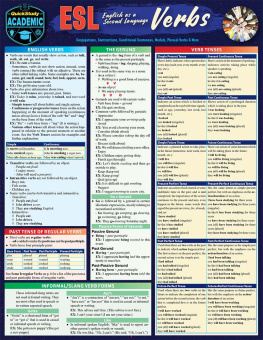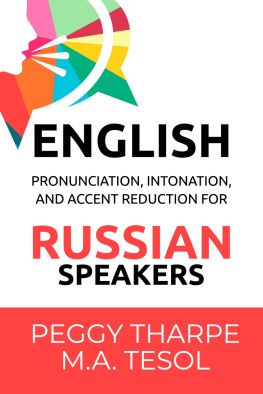

This book is dedicated to Nathaniel Cook and Benjamin Ferguson.
Copyright 2017, 2012, 2000, 1991 by Ann Cook, http://www.americanaccent.com
Portions of this book were previously published by Matrix Press.
Copyright 1989 by Matrix Press.
All rights reserved.
No part of this work may be reproduced or distributed in any form or by any means without the written permission of the publisher.
All inquiries should be addressed to:
Barrons Educational Series, Inc.
250 Wireless Boulevard
Hauppauge, NY 11788
www.barronseduc.com
eISBN: 978-1-4380-6503-8
Revised eBook publication: July 2017
Table of Contents
Index

Track 1
Welcome to American Accent Training. This book and audio is designed to get you started on your American accent. Well follow the book and go through the 17 lessons and all the exercises step by step. Everything is explained, and hyperlinks to the Answers have been provided, wherever applicable.
WHAT IS ACCENT?
Accent is a combination of four main components: voice quality, intonation (speech music), liaisons (word connections), and pronunciation (the spoken sounds of vowels, consonants, and combinations). As you go along, youll notice that youre being asked to look at accent in a different way. Youll also realize that the grammar you studied before and this accent youre studying now are completely different.
Part of the difference is that grammar and vocabulary are systematic and structuredthe letter of the language. Accent, on the other hand, is free form, intuitive, and creativemore the spirit of the language. So, thinking of music, feeling, and flow, let your mouth relax into the American accent.
CAN I LEARN A NEW ACCENT?
Can a person actually learn a new accent? Many people feel that after a certain age, its just not possible. Can classical musicians play jazz? If they practice, of course they can! For your American accent, its just a matter of learning and practicing techniques this book will teach you. It is up to you to use them or not. How well you do depends mainly on how open and willing you are to sounding different from the way you have sounded all your life.
A very important thing you need to remember is that you can use your accent to say what you mean and how you mean it. Word stress conveys meaning through tone or feeling, which can be much more important than the actual words that you use. Well cover the expression of these feelings through intonation in the first lesson.
You may have noticed that I talk fast and often run my words together. Youve probably heard enough English-teacher English where... everything... is... pronounced without having to listen too carefully. Were going to talk just like the native speakers that we are, in a normal conversational tone.
Native speakers often tell people who are learning English to slow down and to speak clearly. This is meant with the best of intentions, but it is exactly the opposite of what a student really needs to do. If you speak fairly quickly, with strong intonation and good voice quality, you will be understood more easily. To illustrate this point, you will hear a Chinese gentleman first trying to speak slowly and carefully and then repeating the same two sentences quickly and with clear intonation. The difference makes him sound like a completely different person.
 Please listen. You will hear the same words twice.
Please listen. You will hear the same words twice.
Hello, my name is Raymond Choon.
You may have to listen a couple of times to catch everything. To help you, every word is also written in the book. By seeing and hearing simultaneously, youll learn to reconcile the differences between the appearance of English (spelling) and the sound of English (pronunciation and the other aspects of accent).
The audio leaves a rather short pause for you to repeat into. The point of this is to get you responding quickly and without spending too much time thinking about your response.
ACCENT VERSUS PRONUNCIATION
Many people equate accent with pronunciation. I dont feel this to be true at all. America is a big country, and while the pronunciation varies from the East Coast to the West Coast, from the southern to the northern states, two components that are uniquely American stay basically the samethe speech music, or intonation, and the word connections, or liaisons. Throughout this program, we will focus on them. In the latter part of the book we will work on pronunciation concepts, such as Cat? Caught? Cut? and Betty Bought a Bit of Better Butter; we also will work our way through some of the difficult sounds, such as TH, the American R, the L, V, and Z.
WHICH ACCENT IS CORRECT?
American Accent Training was created to help people sound American for lectures, interviews, teaching, business situations, and general daily communication. Although America has many regional pronunciation differences, the accent you will learn is that of standard American English as spoken and understood by the majority of educated native speakers in the United States. Dont worry that you will sound slangy or too casual, because you most definitely wont. This is the way a professor lectures to a class, the way a national newscaster broadcasts, the way that is most comfortable and familiar to the majority of native speakers.
WHY IS MY ACCENT SO BAD?
Learners can be seriously hampered by a negative outlook, so Ill address this very important point early. First, your accent is not bad; it is nonstandard to the American ear. There is a joke that goes: What do you call a person who can speak three languages? Trilingual. What do you call a person who can speak two languages? Bilingual. What do you call a person who can only speak one language? American.
Every language is equally valid or good, so every accent is good. The average American, however, truly does have a hard time understanding a nonstandard accent. George Bernard Shaw said that the English and Americans are two people divided by the same language!
Some students learn to overpronounce English because they naturally want to say the word as it is written. Too often an English teacher may allow this, perhaps thinking that colloquial American English is unsophisticated, unrefined, or even incorrect. Not so at all! Just as you dont say the T in listen, the TT in better is pronounced D, bedder. Any other pronunciation will sound foreign, strange, wrong, or different to a native speaker.
LESS THAN IT APPEARS... MORE THAN IT APPEARS
As you will see in the Squeezed-Out Syllables section, some words appear to have three or more syllables, but all of them are not actually spoken. For example, business is not (biziness), but rather (bizness).
Just when you get used to eliminating whole syllables from words, youre going to come across other words that look as if they have only one syllable, but really need to be said with as many as three! In addition, the inserted syllables are filled with letters that are not in the written word. Ill give you two examples of this strange phenomenon. Pool looks like a nice, one-syllable word, but if you say it this way, at best, it will sound like
Next page













 Please listen. You will hear the same words twice.
Please listen. You will hear the same words twice.